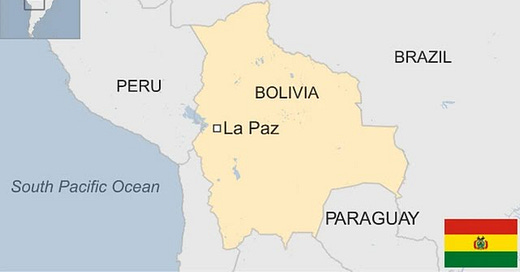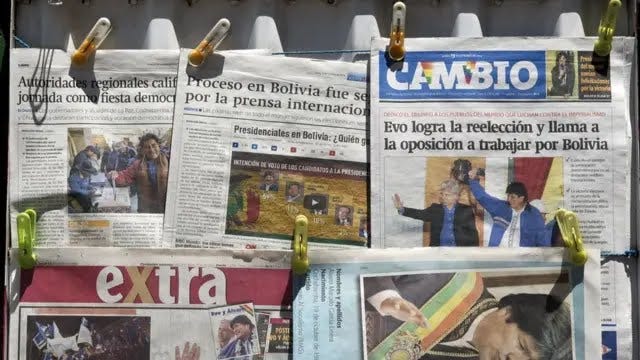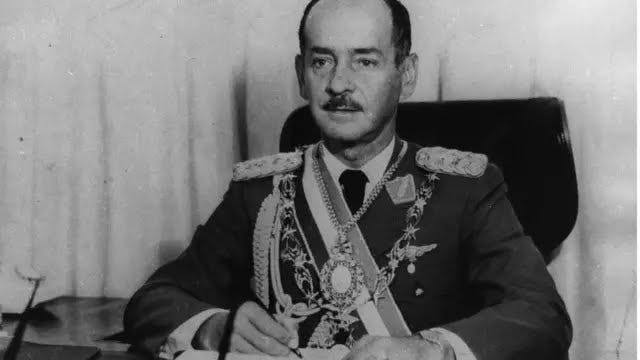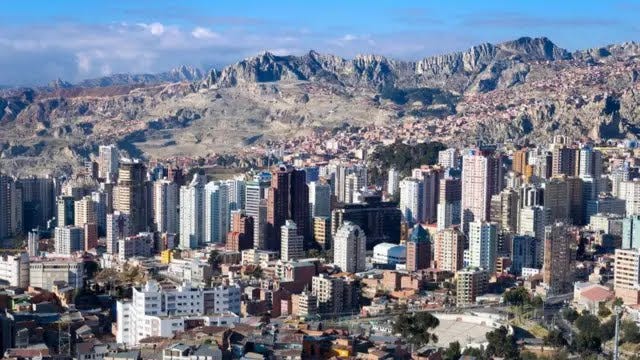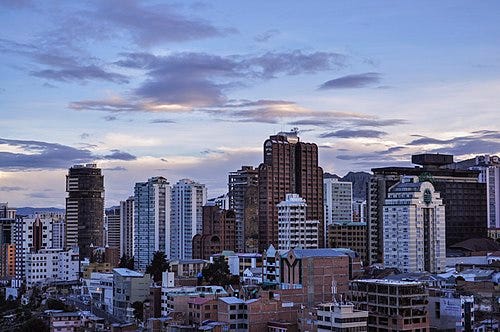Bolivia country profile
A country of extremes, landlocked Bolivia is the highest and most isolated country in South America.
A country of extremes, landlocked Bolivia is the highest and most isolated country in South America.
It has the largest proportion of indigenous people, who make up around two-thirds of the population.
The country has the second-largest reserves of natural gas in South America, but there have been long-running tensions over the exploitation and export of the resource. Indigenous groups say the country should not relinquish control of the reserves, which they see as Bolivia's sole remaining natural resource.
Bolivia is also one of the world's largest producers of coca, the raw material for cocaine. A crop-eradication programme, though easing the flow of conditional US aid, has incensed many of Bolivia's poorest farmers for whom coca is often the only source of income.
PLURINATIONAL STATE OF BOLIVIA: FACTS
Capital: Sucre (constitutional and judicial) La Paz (administrative)
Area: 1,098,581 sq km
Population: 12 million
Languages: Spanish, plus Quechua, Aymara, Guaraní and others
Life expectancy: 71 years (men) 73 years (women)
LEADER
President: Luis Arce
Image caption,President Arce (left) took office in November 2020
Luis Arce won the October 2020 presidential election, returning the Mas socialist party to power after a 12-month interregnum.
Opposition senator Jeanine Áñez declared herself interim president in November 2019 after President Evo Morales resigned in the tumultuous wake of a disputed election.
His bid to win another term in office had led to street protests, and he resigned after the armed forces withdrew their support.
Mr Morales, the first president to come from the Bolivia's indigenous majority, carried out a radical programme after winning power in 2005, aimed at addressing extreme social divisions and inequalities.
Ms Áñez withdrew from the October 2020 presidential election, and President Arce, a colleague of Evo Morales, has pledged to form a government of national unity.
MEDIA
Bolivia's media landscape is dominated by private newspapers and broadcasters
With hundreds of stations, radio is important, especially in rural areas.
The authorities use legal, political and economic means to pressure independent media, says Freedom House.
TIMELINE
Image caption,Hugo Banzer formed a notoriously brutal military regime after taking power in the 1970s. He returned to power via the ballot box in 1997
Some key dates in Bolivia's history:
1538 - Spanish conquer Bolivia, which becomes part of the vice-royalty of Peru.
1545 - Silver Mountain, or Cerro Rico, discovered at Potosi in the southwest, providing Spain with immense wealth.
1824 - Venezuelan freedom fighter Simon Bolivar, after whom Bolivia is named, liberates the country from Spanish rule. One year later, Bolivia becomes independent with Simon Bolivar as its president.
1836-39 - Bolivia enters into a federation with Peru, but the federation fails following Peru's defeat in war with Chile.
1879-84 - Bolivia becomes landlocked after losing mineral-rich, coastal territory in the Atacama to Chile in the War of the Pacific.
1903 - Bolivia loses the rubber-rich province of Acre to Brazil.
1920 - Rebellion by indigenous peoples.
1923 - Revolt by miners is violently suppressed.
1932-35 - Bolivia loses territory to Paraguay after it is defeated in the Chaco War.
1952 - Peasants and miners overthrow military regime; Victor Paz Estenssoro returns from exile to become president and introduces social and economic reforms, including universal suffrage, nationalisation of tin mines and land redistribution, and improves education and the status of indigenous peoples.
1964 - Vice-President Rene Barrientos stages military coup, ushering in a period of political unrest punctuated by uprisings and military coups.
1967 - US helps suppress peasant uprising led by Ernesto "Che" Guevara, who is killed
1971 - Col Hugo Banzer Suarez comes to power after staging military coup.
1980 - General Luis Garcia stages coup after inconclusive elections.
1982 - Military junta hands over power to civilian administration.
1986 - Thousands of miners lose their jobs following the collapse of the tin market.
1989 - Leftist Jaime Paz Zamora becomes president and enters power-sharing pact with former dictator Hugo Banzer.
2005 - Socialist leader Evo Morales wins presidential elections, becoming the first indigenous Bolivian to fill the post.
2006 - Bolivia completes its gas nationalisation programme, giving the state control over the operations of foreign energy firms.
2009 - New constitution giving greater rights to indigenous majority is approved in a national referendum.
2012 - Bolivia temporarily leaves UN Conventions on Narcotics in protest against classifying coca as an illegal drug, signs an agreement with US and Brazil to reduce illegal cocaine production.
2014 - Bolivia submits documents to the United Nations in support of its claim seeking to regain access to the sea from Chile.
2020 - Mas socialist party returns to power after year-long constitutional crisis.
Image caption,At an altitude of 3,650m, La Paz is the highest capital city in the world
The BBC
Overview
Bolivia's economy is the 95th largest globally in nominal terms and 87th by purchasing power parity. It's a lower middle-income country with a Human Development Index of 0.703, ranking 114th. The economy is heavily reliant on natural gas and other minerals, and faces challenges like income inequality, structural issues, and vulnerability to commodity price fluctuations.
Here's a more detailed look:
Key Features:
Resource-rich:
Bolivia has abundant mineral and agricultural resources, including natural gas, gold, zinc, silver, and lithium.
Trade Blocs:
Bolivia is a member of the Andean Community and is joining the Southern Common Market (Mercosur), which could benefit its trade.
Pegged Currency:
The Bolivian currency is pegged to the U.S. dollar, aiming to foster monetary stability.
Poverty Reduction:
The government has made progress in reducing poverty through social programs and policies.
Economic Challenges:
The economy faces issues like insufficient diversification, vulnerability to commodity price swings, high public debt, and structural/institutional problems, including weak rule of law.
State Involvement:
The government's expanding role in the economy, outdated labor laws, and child labor concerns are also problematic.
Tourism Potential:
Bolivia has potential in tourism, manufacturing, and renewable energy, according to Global Finance Magazine.
Recent Developments:
Political Instability:
The political climate in Bolivia remains unstable, with factions within the ruling party and opposition groups vying for power, potentially impacting economic governance and stability.
Economic Growth:
Economic growth is expected to be muted in the short term due to currency volatility, but recent accession to Mercosur could support trade.
Lithium Mining:
Heavy foreign investment in lithium mining could help generate revenue in the medium term, but this may not fully compensate for lost gas revenue.
Economic Backlash:
The government's 2025 budget proposal has drawn criticism for potential debt and inflation concerns, highlighting the economic challenges, according to Voice of America.
Low Foreign Reserves:
Foreign reserves have declined to dangerously low levels, posing risks to the currency peg and potentially leading to a crisis, according to the Economist Intelligence Unit.
Economy of Bolivia
Article Talk
The economy of Bolivia is the 95th-largest in the world in nominal terms and the 87th-largest in purchasing power parity. Bolivia is classified by the World Bank to be a lower middle income country. With a Human Development Index of 0.703, it is ranked 114th (high human development). Driven largely by its natural resources, Bolivia has become a region leader in measures of economic growth, fiscal stability and foreign reserves, although it remains a historically poor country. The Bolivian economy has had a historic single-commodity focus. From silver to tin to coca, Bolivia has enjoyed only occasional periods of economic diversification. Political instability and difficult topography have constrained efforts to modernize the agricultural sector. Similarly, relatively low population growth coupled with low life expectancy has kept the labor supply in flux and prevented industries from flourishing. Rampant inflation and corruption previously created development challenges, but in the early twenty-first century the fundamentals of its economy showed unexpected improvement, leading Moody's Investors Service to upgrade Bolivia's economic rating in 2010 from B2 to B1.The mining industry, especially the extraction of natural gas and zinc, currently dominates Bolivia's export economy.
Economy of
Bolivia
La Paz, the financial centre of Bolivia
Currency
Bolivian Boliviano (BOB)
Fiscal year
Calendar year
Trade organizations
WTO, CAN, UNASUR, Mercosur
Country group
Developing/Emerging
Lower-middle income economy
Statistics
Population
Increase 12,290,945 (2024)
GDP
Increase $105 billion (nominal, 2024)
Increase $131.422 billion (PPP, 2024)
GDP rank
93rd (nominal, 2024)
93rd (PPP, 2024)
GDP growth
4.2% (2018) 2.7% (2019e)
−5.9% (2020f) 2.2% (2021f)
GDP per capita
Increase $4,014 (nominal, 2024)
Increase $10,693 (PPP, 2024)
Source: Wikipedia

